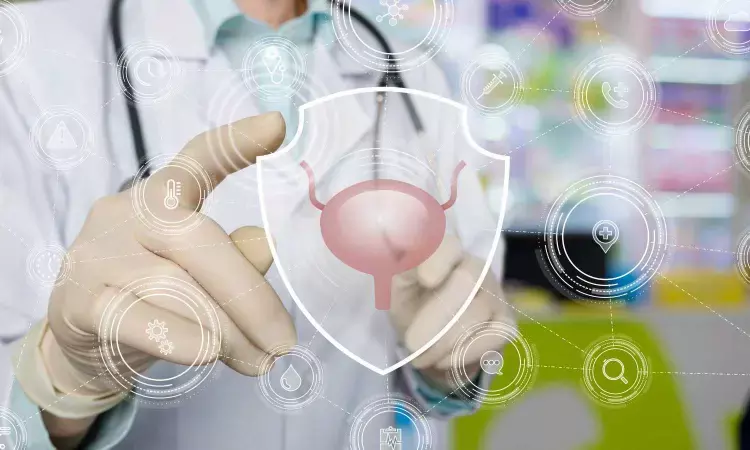- Home
- Medical news & Guidelines
- Anesthesiology
- Cardiology and CTVS
- Critical Care
- Dentistry
- Dermatology
- Diabetes and Endocrinology
- ENT
- Gastroenterology
- Medicine
- Nephrology
- Neurology
- Obstretics-Gynaecology
- Oncology
- Ophthalmology
- Orthopaedics
- Pediatrics-Neonatology
- Psychiatry
- Pulmonology
- Radiology
- Surgery
- Urology
- Laboratory Medicine
- Diet
- Nursing
- Paramedical
- Physiotherapy
- Health news
- Fact Check
- Bone Health Fact Check
- Brain Health Fact Check
- Cancer Related Fact Check
- Child Care Fact Check
- Dental and oral health fact check
- Diabetes and metabolic health fact check
- Diet and Nutrition Fact Check
- Eye and ENT Care Fact Check
- Fitness fact check
- Gut health fact check
- Heart health fact check
- Kidney health fact check
- Medical education fact check
- Men's health fact check
- Respiratory fact check
- Skin and hair care fact check
- Vaccine and Immunization fact check
- Women's health fact check
- AYUSH
- State News
- Andaman and Nicobar Islands
- Andhra Pradesh
- Arunachal Pradesh
- Assam
- Bihar
- Chandigarh
- Chattisgarh
- Dadra and Nagar Haveli
- Daman and Diu
- Delhi
- Goa
- Gujarat
- Haryana
- Himachal Pradesh
- Jammu & Kashmir
- Jharkhand
- Karnataka
- Kerala
- Ladakh
- Lakshadweep
- Madhya Pradesh
- Maharashtra
- Manipur
- Meghalaya
- Mizoram
- Nagaland
- Odisha
- Puducherry
- Punjab
- Rajasthan
- Sikkim
- Tamil Nadu
- Telangana
- Tripura
- Uttar Pradesh
- Uttrakhand
- West Bengal
- Medical Education
- Industry
Wireless device enables noninvasive monitoring of bladder pressure in patients having overactive bladder

USA: A wireless, catheter-free intravesical pressure sensor, the UroMonitor is the first device that enables catheter-free telemetric ambulatory bladder pressure monitoring in humans, a pilot study published in the July issue of The Journal of Urology has shown. The device enables noninvasive monitoring of bladder pressure in patients with overactive bladder.
"The device appeared safe and well tolerated, did not impede lower urinary tract function, and could reliably identify bladder events compared to urodynamics," the researchers wrote in their study.
"The UroMonitor is the first device to enable catheter-free telemetric ambulatory bladder pressure monitoring in humans," comments senior author Margot S. Damaser, PhD, of Cleveland Clinic. "With further evaluation, the UroMonitor may provide a safe and reliable way to identify bladder events under more natural conditions, compared to standard testing in the urodynamic lab."
New technology for continuous, catheter-free bladder pressure monitoring
Patients with incontinence and other urinary problems routinely undergo urodynamic testing to assess the functioning of the lower urinary tract. However, these tests have important limitations – including the need for catheter placement and instillation of fluid into the bladder, which can be uncomfortable for the patient and may not reflect normal daily functioning.
The UroMonitor was developed as a noninvasive approach for assessing the function of the lower urinary tract without needing catheter placement. The UroMonitor is a small, flexible device- no more than two inches across – placed into the patient's bladder. Once in place, the device wirelessly transmits bladder pressure data to a small radio receiver taped to the lower abdomen.
In a pilot study to evaluate clinical safety and accuracy, Dr. Damaser and colleagues tested the UroMonitor in 11 women (median age 67 years) with symptoms of overactive bladder. After the patients underwent initial urodynamic testing, the UroMonitor device was inserted into the bladder via the urethra. Urodynamic testing was then repeated, with simultaneous transmission of bladder pressure data.
After catheter removal, the UroMonitor provided further bladder pressure measurements as the patients ambulated (average time 60 minutes) and eventually urinated, after which the device was easily removed. Patient comfort and pain scores were monitored throughout the study and at two days' follow-up.
With further study, UroMonitor may avoid invasive urodynamic testing in some patients
The UroMonitor device was quickly and easily placed: median insertion time 17.5 seconds. There were no changes in urodynamic measurements made before versus after device placement. One patient had signs of bladder muscle spasms (detrusor overactivity) after UroMonitor placement. However, detrusor overactivity was much more frequent during urodynamic testing, possibly due to catheter-related irritation of the bladder.
Clinically relevant changes in bladder pressure detected by the UroMonitor aligned well with those measured on urodynamic testing. Ninety-eight percent of bladder pressure events detected by urodynamic testing were accurately detected by the UroMonitor. A few events were missed due to radio interference – a technical issue corrected later in the study.
Average differences in simultaneous urodynamic and UroMonitor measurements were small. Patients reported little or no pain during most phases of the study, and there were no adverse effects or complications related to the device.
The UroMonitor provides "a safe and clinically feasible approach for telemetric ambulatory urodynamic monitoring," the preliminary study suggests. The device performs "exceedingly well" in identifying clinically significant bladder pressure events that could be captured only by standard urodynamic studies with catheter placement.
While further studies are needed, the UroMonitor may "more accurately reproduce bladder function" in patients with lower urinary tract symptoms. Using this and other noninvasive methods, "[U]rologists may be able to more adequately capture a patient's true voiding behaviours and defer invasive urodynamic studies in select patients," Dr. Damaser and coauthors conclude.
Reference:
Brendan T. Frainey, Steve J. A. Majerus, Samir Derisavifard, Kevin C. Lewis, Anna R. Williams, Brian M. Balog, Robert S. Butler, Howard B. Goldman, and Margot S. Damaser, https://doi.org/10.1097/JU.0000000000003451.
Dr Kamal Kant Kohli-MBBS, DTCD- a chest specialist with more than 30 years of practice and a flair for writing clinical articles, Dr Kamal Kant Kohli joined Medical Dialogues as a Chief Editor of Medical News. Besides writing articles, as an editor, he proofreads and verifies all the medical content published on Medical Dialogues including those coming from journals, studies,medical conferences,guidelines etc. Email: drkohli@medicaldialogues.in. Contact no. 011-43720751


